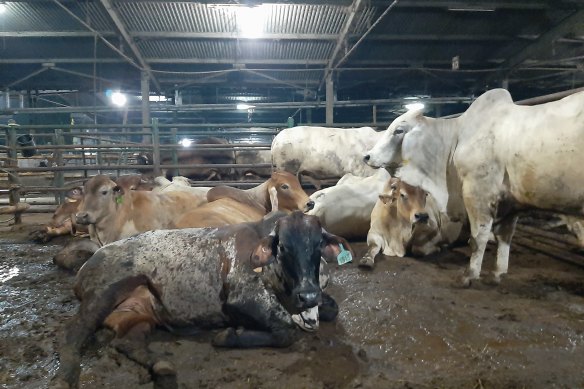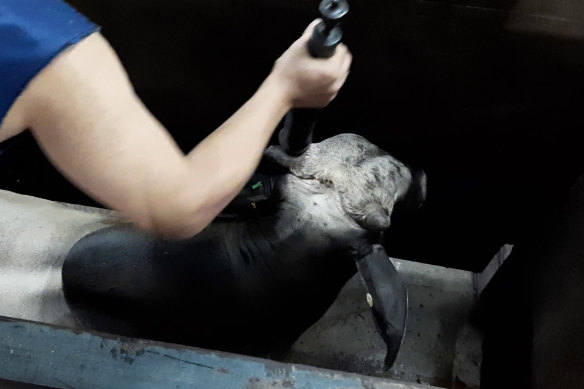Investigation finds Indonesian abattoirs violated live export rules
Save articles for later
Add articles to your saved list and come back to them any time.
GRAPHIC CONTENT
Singapore: An Australian government investigation has found violations of live export trade standards at seven Indonesian abattoirs where Australian producers sent cattle, after assessing shocking footage captured inside slaughterhouses on Java and Sumatra.
The vision, collected undercover by the Asian arm of People for the Ethical Treatment of Animals (PETA) in April and May 2021 and published by this masthead in November that year, showed cattle still kicking up to five minutes after having their throats slit and, in one filmed incident, being hoisted and hacked at with a knife while still moving.
A steer was also jabbed with a metal prod over 60 times and had its tail yanked forcefully after a failed stunning attempt at an abattoir near Jakarta.
A new report released by Australia’s Department of Agriculture, Fisheries and Forestry determined there were “systematic issues” at the facilities, one of which had committed a major breach of Australian government’s Exporter Supply Chain Assurance System (ESCAS) standards while all were guilty of “minor non-compliance”.
It identified non-compliant slaughter procedures at all the abattoirs and excessive and inappropriate use of force at two of them. It also found that workers at six of the seven had failed to properly perform checks on consciousness before slaughter and on death after slaughter. The report said it was not possible to fully assess the state of the cattle but it “appeared likely” cattle were unconscious before slaughter and dead before dressing – the stage at which they are cut up for processing.
The footage taken of Indonesian abattoirs was handed to the Australian government in June 2021.Credit: PETA Asia
However, it discovered inconsistencies in exporters’ interpretations of animal welfare rules “especially regarding procedures by abattoir staff to assess unconsciousness following stunning and verify death following slaughter”.
It also revealed that an Australian exporter had recognised ear tags in the video from an abattoir that it did not have approval to send cattle to at that point. The exporter discovered the cattle had been sold to that slaughterhouse by a butcher who falsified traceability documents, according to the government report.
The findings have a direct impact on the standing of Australia’s $1.4 billion live-cattle export industry. Almost a quarter of all livestock exports go to Indonesia, which has for years imported live cattle from Australia only.
Seven of Australia’s nine live cattle exporters to the South-East Asian nation had approved supply chains in one or more of the abattoirs investigated. Of those, six Australian exporters were responsible for Australian cattle in the facilities in question at the time the undercover video was taken, the ESCAS report said.
But the regulator indicated no further action was needed against the seven abattoirs, concluding that training and corrective remedies implemented by the exporters and conditions imposed by the government “were collectively effective in addressing these non-compliances and preventing their recurrence”. Specific responsibility for each exporter could not be determined because of difficulty identifying the cattle in the vision, the report said.
A steer is stunned at an abattoir near Jakarta.Credit: PETA Asia
More than two years after the footage was taken, it is an outcome that has disappointed the organisation that brought the maltreatment to light.
“As New Zealand finally bans live-animal export by ship, the Australian Department of Agriculture’s response to cruelty documented in overseas abattoirs importing Australia’s cattle – and the entire regulatory review process – has once again proved impotent and pathetic,” said PETA senior communications advisor Emily Rice.
“Pointless, taxpayer-funded reviews of this barbaric industry are as useful as a chocolate hairdryer. Labor must commit to ending live export for all animals now.”
New Zealand sent its last shipments of live exports by sea last month, having banned them on welfare grounds. Unlike Australia, however, it had only dispatched livestock abroad for breeding purposes since banning live exports for slaughter in 2008.
The Albanese government has pledged to phase out live sheep exports by sea, forming an advisory panel chaired by senior public servant Phillip Glyde that includes former RSPCA chief Heather Neil and ex-Labor minister Warren Snowdon.
It will not occur in Labor’s current term of government but has been opposed by the Australian Livestock Exporters Council (ALEC), which has branded the move unwarranted and a risk to as many as 3000 jobs locally as well as to trading partners.
Asked about the report, ALEC chief executive Mark Harvey-Sutton flatly rejected criticism of the review process. He said PETA had supplied more than 200 hours of footage and the number of non-compliance issues found demonstrated they had been isolated incidents.
“No industry likes to see non-compliances but to put it in perspective we went public with the details of this investigation as soon as we became aware of PETA raising these concerns,” he said.
“It needs to be remembered that at this time Indonesia was probably one of the worst affected countries in the world with COVID-19 and actually inspecting these facilities in person was extremely difficult. That’s not an excuse but the clear thing is exporters, once made aware of the concerns, reacted rapidly, did so as a group and corrected the non-compliances.”
Australia exported 70,244 cattle to Indonesia between January and March, among 291,693 total animal exports in that period.
Indonesia imported almost 700,000 cattle from Australia before the pandemic in 2019. Those numbers have since fallen amid rising beef prices and Indonesia is looking to Brazil for a cheaper alternative supply.
Get a note directly from our foreign correspondents on what’s making headlines around the world. Sign up for the weekly What in the World newsletter here.
Most Viewed in World
From our partners
Source: Read Full Article

